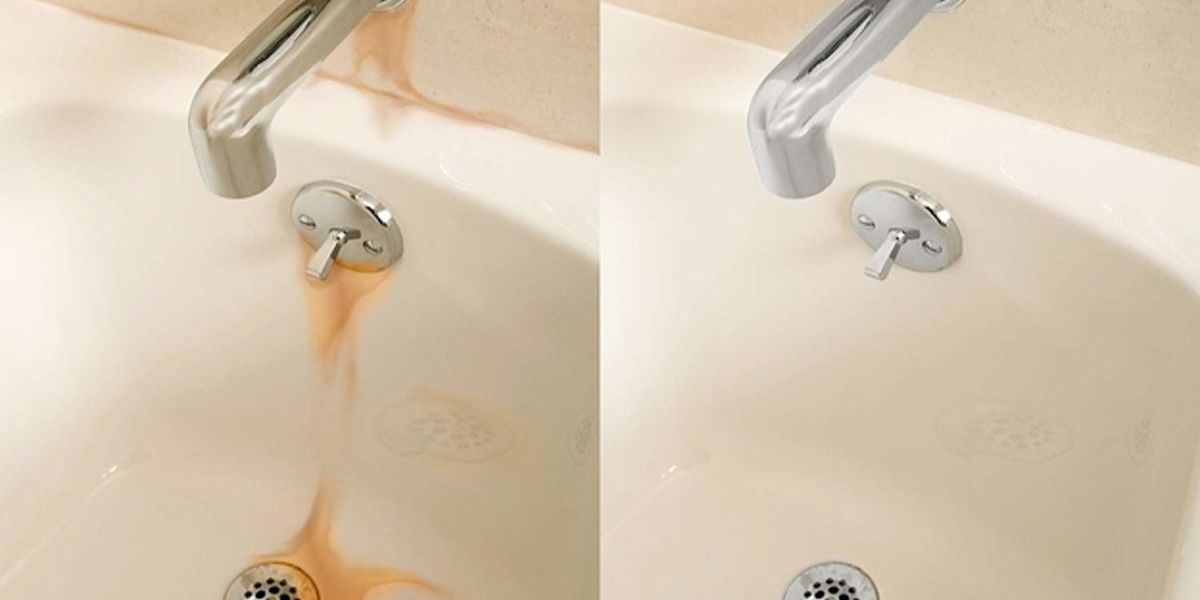How to Remove Rust Stains from a Fiberglass Bathtub?
Ugh, I woke up this morning to find rust stains in my fiberglass bathtub. You know those ugly, orangey-brown splotches that look like they’re permanently affixed to the surface? Not the aesthetic I’m going for in my bathroom decor.
As a long-time homeowner, I’ve dealt with my fair share of brown rust stains in the tub. They’re pesky and stubborn, but not impossible to remove with the right techniques. After years of trial and error, I’ve got a few trusty methods up my sleeve for getting rid of them.
In this article, I’ll share what I’ve learned about where these stains come from in the first place and walk through some DIY fixes you can try at home. We’ll cover some gentler homemade solutions for light stains as well as stronger chemical cleaners for really persistent marks.
Related post: 13 Best Homemade Fiberglass Shower Cleaners For You
Why Rust Keeps Staining My Fiberglass Tub?
Before we dig into removal tactics, it helps to understand what’s causing those bothersome rust stains so you can try to prevent their return.
Fiberglass tubs are porous, so they easily absorb contaminants from water and moisture in the air. Rust forms when iron particles in the water supply or tools/objects touching the tub oxidize in a wet, humid environment.
Here are some common ways rust keeps invading your bathtub:
- Old pipes and plumbing can corrode and leach iron into your water over time. If you have well water, it may naturally contain a high iron content too.
- Exposing the tub to iron-based objects like tools, nails, or cast iron fixtures resting directly on the surface can cause rust stains over time.
- Humidity and dampness attracts moisture into the porous fiberglass. This wet environment kickstarts the chemical reaction for oxidation, forming orangey rust deposits.
- Previous rust stains that weren’t thoroughly removed can leave behind iron residue, making it easier for stains to reappear.
Okay, now that we know why fiberglass tubs rust so easily, let’s get to the good stuff – actually getting rid of those stains!
Homemade Remedies for Light Rust Stains
For small surface stains that aren’t too stubborn, try one of these homemade remedies first:
Baking Soda and Vinegar Paste
Making a paste with baking soda and vinegar is one of my go-to methods for tackling light rust stains. The fizzy reaction helps lift the stain, while the acids in the vinegar work to dissolve the rust.
Just mix a spoonful of baking soda with enough vinegar to make a thick paste. Apply it directly to the stain and let it bubble for a few minutes before scrubbing with a soft brush or sponge. The stain should wipe away, but you may need to repeat this process a few times for tough spots. Give it a final rinse and you should be rust-free!
Lemon Juice
Thanks to the citric acid, lemon juice is another mild acid that breaks down rust stains nicely. I simply rub a freshly sliced lemon over the stained area and let it sit for at least 15 minutes before rinsing clean.
For tougher stains, let the lemon juice soak in for a few hours or overnight if possible. The longer the juice penetrates, the better it lifts the stain.
White Vinegar
You can also pour plain white vinegar directly onto light rust stains in the tub. Let it soak for 15-30 minutes before gently scrubbing with a brush or sponge.
I like to pour vinegar into a spray bottle for easier application on vertical surfaces. Just spray the stain thoroughly and let the vinegar work its magic!
Salt
For light surface stains, salt can also be an effective abrasive scrub. Simply dampen the stain and generously sprinkle on plain table salt. Use a sponge or soft cloth to gently rub the salt over the rust. Rinse thoroughly when you’re done scrubbing.
The graininess of the salt provides that satisfying scouring action to loosen staining, without being too harsh on fiberglass. Give it some elbow grease and the salt does the job!
Removing Stubborn Rust Stains
DIY solutions are great for mild stains, but some rust truly adheres to the tub and needs the big guns.
For seriously stubborn, set-in stains, these heavy-duty removers are your best bet:
Oxalic Acid-Based Rust Removers
Oxalic acid is the key active ingredient for dissolving tough rust stains. You can find it in rust removal products like Bar Keepers Friend and Whink.
Just check the label for oxalic acid on the ingredients list. Apply a generous amount directly to the stain and let it sit for 10-15 minutes before scrubbing and rinsing. Be sure to rinse very thoroughly, as prolonged exposure to strong acids can damage the tub over time.
Phosphoric Acid-Based Cleaners
Another acid suitable for rust is phosphoric acid, found in naval jelly. It helps loosen the iron oxide stains by converting the crystals into a form that can be rinsed away.
Spread a thick layer of naval jelly paste onto the stained area and let it sit overnight if possible. Then simply scrub away the gunk and rinse. I recommend wearing gloves when handling caustic acid cleaners like this.
Bleach-Based Gel Cleaners
For vertical surfaces like the tub walls, I prefer using a thicker gel cleaner containing bleach. The gel clings nicely to the sides of the tub without dripping everywhere. As the bleach sits, it helps break down that orange-brown discoloration.
Check the product instructions for the recommended contact time before rinsing. And remember to open the windows – bleach fumes aren’t pleasant!
Liquid Rust Dissolvers
Another option is a liquid rust dissolver spray. These acidic formulas are designed to quickly penetrate and lift rust stains.
Simply spray the product liberally onto the affected area. Most recommend letting it soak 5-10 minutes before rinsing. Just be cautious using these sprays on fiberglass, as they can damage the surface if left too long.
When It’s Time to Call for Backup?
Sometimes DIY rust removal just isn’t getting the job done, and it’s best to call in a professional for backup. Signs it’s time to bring in help include:
- Stains covering a large area of the tub
- Extremely dark or thick rust that keeps returning
- Vertical rust lines indicating leaks in the piping
- Concern about damaging the tub surface with harsh chemicals
A professional will have commercial-grade rust removers, as well as the experience to fully clean rust stains and seal the tub to prevent rapid recurrence.
Yes, it’s an added expense, but it saves the headache of dealing with forever reappearing rust you can’t seem to banish. Plus, your tub will look shiny and new again!
Keeping the Rust Away for Good
Now that you know how to obliterate even the most stubborn rust stains, let’s talk about keeping them away for good. Here are my top tips for preventing encore rust performances:
- Use a water softener to reduce mineral content if you have hard water. This limits the amount of iron exposure over time.
- Immediately wipe up any moisture and liquid spilled in the tub. Don’t give it a chance to seep in.
- Open the curtain or shower doors after bathing so the tub fully air dries to discourage mold growth.
- Install proper bathroom ventilation to decrease humidity.
- Clean with vinegar or other acid products regularly to prevent the buildup of mineral deposits.
- Avoid letting tools or other iron objects sit directly on the bare tub surface.
- If stains return frequently, consider recoating or resurfacing the tub to seal out contaminants.
- Keep an eye out for any cracks or leaks indicating possible piping issues, and repair promptly.
With diligence, care, and the right cleaning techniques, you can send rust stains packing for good. As much as I hate dealing with rust, the satisfaction of getting that sparkling white tub back makes all that scrubbing worthwhile. Hopefully, these tips will help you kick rust to the curb too. Let me know if you have any other questions – I’m happy to help!
Frequently Asked Questions
Why does my fiberglass bathtub get rust stains even though I don’t use it very often?
Fiberglass is porous, so it can absorb contaminants from humidity in the air over time. The iron particles then oxidize when moisture is present, causing rust stains. Using a bathroom fan to reduce humidity levels can help prevent this.
I tried removing a rust stain with lemon juice but it didn’t work. What should I try next?
For stubborn stains, move on to a stronger acid-based remover designed specifically for dissolving rust, such as Bar Keeper’s Friend or Whink. Be sure to rinse thoroughly afterward.
Is there a way to seal my fiberglass tub so it won’t get stained as easily?
Yes, you can apply a fiberglass tub refinishing kit or epoxy coating to seal the surface. This prevents contaminants from penetrating the pores and makes the tub easier to keep clean.
Why do some rust stains keep reappearing shortly after I remove them?
This usually indicates an ongoing source of rust is present, such as high iron in your water supply or a small leak introducing moisture. Try using a water softener and inspect pipes for leaks to address the root cause.
I have some rust-colored vertical streaks in my tub. What causes this?
Vertical streak stains are usually a sign of small leaks in the plumbing above the tub. The water seeps through containing iron that then oxidizes into rust marks. Have your pipes inspected and repaired promptly.
Is it safe to use bleach-based cleaners on fiberglass tubs?
Yes, bleach can be used safely in moderation to remove stubborn stains and disinfect the tub. Just don’t let it sit too long before rinsing, as prolonged exposure could damage the finish.
Will a rust stain eventually wear off on its own without scrubbing?
Unfortunately no, a rust stain will not disappear on its own over time. The oxidation process binds the iron permanently to the surface. Attempting to remove rust is required.
Can I use baking soda and vinegar to remove rust stains from a fiberglass tub?
Yes, making a paste with these two ingredients can help lift and dissolve light rust stains. Just don’t use vinegar solutions too frequently, as it could dull the finish over time.

William J. Bullock is a licensed plumber with over 15 years of experience installing and repairing bathtubs. He runs his own plumbing company in Greenville and serves residential and commercial clients. William is dedicated to providing honest, transparent advice to help homeowners make informed decisions about their bathroom renovations.
He has established expertise in selecting bathtubs, planning custom installations, diagnosing issues, and completing repairs. William aims to share practical tips and reliable recommendations based on extensive hands-on work. When he isn’t on a job site, William enjoys spending time with his family and volunteering at local community events. He takes pride in delivering quality service and enjoys helping people upgrade their homes.







